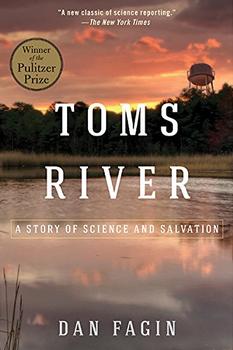Summary | Excerpt | Reviews | Beyond the Book | Readalikes | Genres & Themes | Author Bio

A Story of Science and Salvation
by Dan Fagin
Janson checked and learned that there were two Superfund sites in Toms River and that neither had been the subject of an EPA health study. Was the agency considering launching such a study in Toms River? No, it was not, she was told. So Janson decided to call another federal agency, one that few members of the public had ever heard of. The Agency for Toxic Substances and Disease Registry was, and still is, a backwater in the federal environmental bureaucracy. Congress created it in 1980, when anxiety about hazardous waste was at its zenith, just seven months after the evacuation of Love Canal. The idea was that the EPA would oversee dumpsite cleanups, while the ATSDR would advise the EPA on the health hazards posed by each waste site. But the ATSDR had very little money to do its job, especially as the number of Superfund sites ballooned in the late 1980s. By 1996, the EPA was spending well over one billion dollars per year (about 20 percent of its budget) on Superfund; the entire ATSDR budget, meanwhile, was just $60 million.
Steven Jones came to the ATSDR in 1992 from the EPA, where he had worked on Superfund cleanups in the Midwest. His new title, deputy regional director, suggested sweeping authority; the reality was that the ATSDR's regional office, which occupied a small corner of the EPA's space in Manhattan, consisted of just two managers: Jones and his boss. Their main responsibility was to make sure that state and local environmental health agencies were doing the work the short-staffed ATSDR could not do itself. Only rarely did Jones field calls from the public about supposed cancer clusters; when he did, they usually ended in mutual frustration. Like Laura Janson, he had been around long enough to know that ordinary citizens rarely understood what constituted a true cancer cluster.
So when Steve Jones's office phone rang one morning in March of 1995 and the woman on the end of the line started talking about a possible cluster in Toms River, New Jersey, there was no reason to think it would be anything more than another dead-end conversation. As Jones listened, though, he heard some things that caught his attention.
For starters, the caller was not a typical anxious citizen. Laura Janson introduced herself as an EPA employee, explaining that she was calling unofficially to relay the concerns of an oncology nurse, her sister-in-law, at The Children's Hospital of Philadelphia. Unlike so many callers, Janson was not passing along a vague report in which all of the most common types of adult cancer— lung, breast, skin, and all the rest— were lumped together. She spoke instead about much rarer children's cancers, especially brain tumors. "What she was expressing to me was very specific," Jones remembered. "I felt like I wouldn't be doing my job if I didn't follow up. Someone needed to look at it."
Like Lisa Boornazian and Laura Janson, Jones knew almost nothing about the sordid history of chemical pollution in Toms River. Also like the two sisters-in-law, he was neither a rebel nor a starry-eyed idealist, and he was anything but a naive civilian. Jones, Boornazian, and Janson all worked inside sprawling, risk-averse bureaucracies. They had been around long enough to be a tad cynical about the outsiders, the amateurs who were always demanding investigations without knowing the facts. And yet, in this case, all three felt that they could not ignore what they were hearing. The numbers were too high to dismiss as coincidence, and each case represented a face, a child, and a family.
Under the circumstances, Steve Jones felt that he could not say no to the EPA employee who called him, just as Laura Janson felt that she could not say no to her sister-in-law, the oncology nurse. As for Lisa Boornazian, she, too, felt that she had no real choice. She had to speak up for the memory of Carrie-Anne Carter and all the other Toms River children who had come through the cancer ward. They deserved an answer.
Excerpted from Toms River by Dan Fagin. Copyright © 2013 by Dan Fagin. Excerpted by permission of Bantam, a division of Random House, Inc. All rights reserved. No part of this excerpt may be reproduced or reprinted without permission in writing from the publisher.
Wherever they burn books, in the end will also burn human beings.
Click Here to find out who said this, as well as discovering other famous literary quotes!
Your guide toexceptional books
BookBrowse seeks out and recommends the best in contemporary fiction and nonfiction—books that not only engage and entertain but also deepen our understanding of ourselves and the world around us.